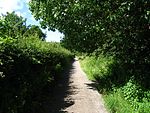Dee Estuary

The Dee Estuary (Welsh: Aber Dyfrdwy) is a large estuary by means of which the River Dee flows into Liverpool Bay. The estuary starts near Shotton after a five-mile (8 km) 'canalised' section and the river soon swells to be several miles wide forming the boundary between the Wirral Peninsula in north-west England and Flintshire in north-east Wales. The Dee Estuary's largest towns along it include Holywell, Flint, Connah's Quay, Shotton, Queensferry, Saltney Ferry, Heswall, West Kirby and Neston as well as other villages and towns alongside it. The A548 also passes along the estuary in Wales and parts of Cheshire West and Chester and Merseyside in England. The North Wales Coast Line follows the course of the Dee Estuary between Prestatyn and Chester.
Excerpt from the Wikipedia article Dee Estuary (License: CC BY-SA 3.0, Authors, Images).Dee Estuary
Wirral
Geographical coordinates (GPS) Address Nearby Places Show on map
Geographical coordinates (GPS)
| Latitude | Longitude |
|---|---|
| N 53.309 ° | E -3.157 ° |
Address
Heswall
CH60 4RJ Wirral
England, United Kingdom
Open on Google Maps






